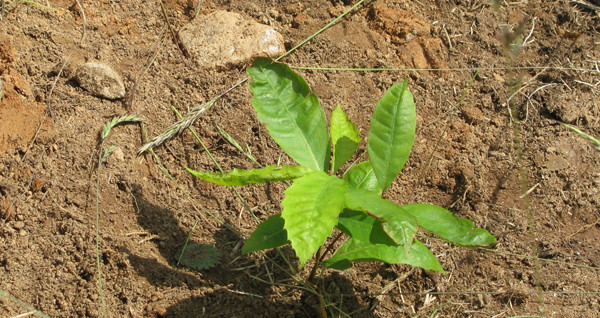
Blue Ridge Heritage, Inc. (BRHI), in partnership with The American Chestnut Foundation (TACF) is planting native American chestnuts on the property BRHI purchased last year (in the Rocky Knob area of the Blue Ridge Parkway). These plantings are test sites, allowing the group to judge overall sun/shade, soil composition, and drainage for a future planting of the potentially blight-resistant chestnuts that TACF has named “Restoration Chestnuts.”
The test plots were selected by BRHI officers and vetted by Matt Brinckman, Mid-Atlantic Regional Science Coordinator, TACF. Brinckman and his summer intern, Jennifer Santoro, who is a graduate student at Duke University earning her master of forestry and master of environmental management degrees, brought 27 native American saplings to the BRHI property to plant on Tuesday, May 28, 2013. The group planted test areas with 5 and 6 saplings in each area. Although these non-resistant trees will eventually succumb to the blight, the partnership reps hope that they will live long enough to offer good data about which sites on the property the Restoration Chestnuts, to be planted in the future, will be able to thrive.
“We would love to allow visitors to this area to see surviving tall chestnut trees, which have been absent from this area for decades,” says Steve Swartz, BRHI president. “We are looking forward to a long-lasting partnership with The American Chestnut Foundation to mutually move our shared goals forward.”
Once the mighty giants of the eastern forests, American chestnuts stood up to 100 feet tall, and numbered in the billions. They were a vital part of the forest ecology, a key food source for wildlife and an essential component of the human economy. In 1904 the fungal pathogen responsible for chestnut blight, accidentally imported from Asia, spread rapidly through the American chestnut population. By 1950 it had killed virtually all the mature trees from Maine to Georgia. Several attempts to breed blight resistant trees in the mid-1900s were unsuccessful.
Blue Ridge Heritage, Inc. is a 501(c)(3) nonprofit dedicated to promoting education and economic development through place-based programs related to the natural and cultural heritage of Floyd and Patrick Counties. BRHI’s educational offerings will focus on the period of history between 1900 and 2000; this “Century of Change” includes the rise and fall of the “chestnut economy” in mountainous southwest Virginia. One goal of the group is to partner with TACF and showcase Restoration Chestnuts on the property along the Blue Ridge Parkway.
In 1983, a dedicated group of scientists formed The American Chestnut Foundation and began a special breeding process, which in 2005 produced the first potentially blight-resistant trees called Restoration Chestnuts 1.0. Now assisted by nearly 6,000 members and volunteers in 16 state chapters, the organization is undertaking the planting of Restoration Chestnuts 1.0 in select locations throughout the eastern US as part of the Foundation’s early restoration efforts. TACF is a 501(c)(3) conservation organization headquartered in Asheville, NC.
For more information about BRHI or TACF, please contact Lee Chichester: en.avws@renoclaft or 540-593-2011.

